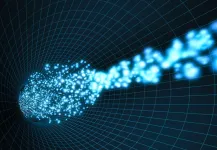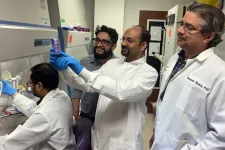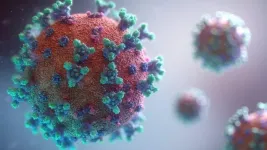(Press-News.org) Whenever SLAC National Accelerator Laboratory’s linear accelerator is on, packs of around a billion electrons each travel together at nearly the speed of light through metal piping. These electron bunches form the accelerator’s particle beam, which is used to study the atomic behavior of molecules, novel materials and many other subjects. But trying to estimate what a particle beam actually looks like as it travels through an accelerator is difficult, leaving scientists often with only a rough approximation of how a beam will behave during an experiment.
Now, researchers at the Department of Energy’s SLAC, the DOE’s Argonne National Laboratory and the University of Chicago have developed an algorithm that more precisely predicts a beam’s distribution of particle positions and velocities as it zips through an accelerator. This detailed beam information will help scientists perform their experiments more reliably – a need that is becoming increasingly important as accelerator facilities operate at higher and higher energies and generate more complex beam profiles. The researchers detailed their algorithm and method in April in Physical Review Letters.
“We have a lot of different ways to manipulate particle beams inside of accelerators, but we don’t have a really precise way to describe a beam’s shape and momentum,” SLAC accelerator scientist and lead co-author Ryan Roussel said. “Our algorithm takes into account information about a beam that is normally discarded and uses that information to paint a more detailed picture of the beam.”
Typically, researchers describe the positions and speeds of particles in a beam in terms of a few summary statistics that provide a rough shape of the beam overall – but that approach throws out a lot of potentially useful information. Alternatively, beam scientists can take many measurements of the beam itself and try to reconstruct, sometimes using machine learning, what the beam would look like under different experimental circumstances – but those methods require a lot of data and a lot of computational power.
For this study, the team tried a new approach: They built a machine learning model that uses our understanding of beam dynamics to predict the distribution of particles positions and speeds within the beam, collectively known as the beam's phase space distribution.
To test their ideas, the team used their model to interpret experimental data from the Argonne Wakefield Accelerator at the DOE's Argonne National Laboratory. Including the physics of particle beam dynamics with the experimental data allowed the researchers to accurately reconstruct fine details of the beam using only 10 data points – a task that might take up to 10,000 data points for some machine learning models that don’t include a model of beam physics.
“Most machine learning models don't directly include any notion of particle beam dynamics to speed up learning and reduce the amount of data required,” SLAC accelerator scientist and co-author Auralee Edelen said. “We've shown that we can infer very complicated high-dimensional beam shapes from astonishingly small amounts of data."
The algorithm can currently reconstruct a model of a beam along its up-down and left-right axes, as if the particle bunch were a pancake moving down the accelerator path. This type of reconstruction is called 4D beam phase space. Next, researchers want to demonstrate the algorithm experimentally on reconstructing full 6D phase space distributions, which includes particle positions and speed along the direction in which the beam is traveling.
Overall, the algorithm is a major paradigm shift in the way we analyze experimental accelerator data at facilities today, Roussel said.
“We can now use particle beam data in a more comprehensive, powerful way to improve our scientific goals at accelerators everywhere,” he said.
END
Researchers develop clever algorithm to improve our understanding of particle beams in accelerators
The algorithm pairs machine-learning techniques with classical beam physics equations to avoid massive data crunching
2023-05-01
ELSE PRESS RELEASES FROM THIS DATE:
Internet search trends reflect concerns following Supreme Court health care decisions
2023-05-01
Internet search trends may immediately capture how society seeks information related to reproductive health care, according to new research from Indiana University researchers.
The study, published today in JAMA Health Forum, analyzed internet searches for abortion- and contraception-related terms following the June 24, 2022, ruling by the United States Supreme Court on Dobbs v. Jackson Women’s Health Organization. Researchers found that searches increased much more in states where reproductive health care access was more likely to be immediately restricted following the decision.
“It is still fairly early to see what will be the actual changes in reproductive ...
Having daughters might not move politicians’ votes on women’s issues to the left, after all
2023-05-01
Politicians who are the parents of daughters provide researchers with a “natural experiment” to test how personal circumstances influence legislators’ roll call votes. Research published in 2008, by author Ebonya Washington, showed that members of the U.S. House of Representatives with daughters cast more liberal votes on women’s issues during the period between 1997 and 2005. But another study published in 2019 by researchers Mia Costa et al., covering the period between 2007 and 2017, did not ...
Lee studying how to improve access to disability service information in Virginia
2023-05-01
Myeong Lee, Assistant Professor, Information Sciences and Technology, is leading a study to help people with disabilities and their families in Virginia access information about disability services more easily.
The 2022 Information Access Assessment report by the Virginia Board for People with Disabilities (VBPD) revealed that many people with disabilities and their families struggle to find the necessary information about disability services, even when they actively seek help from service agencies. ...
Herpes study adds to understanding of viral reinfections, how to potentially prevent them
2023-05-01
A new study on herpes infections of the eye from University of Illinois Chicago researchers helps shed light on the question of viral reinfections by identifying a key protein involved in viral reinfections that could be targeted by antiviral drugs.
The UIC team examined how the heparanase protein, which is present in all our cells, affects reinfection from the herpes simplex virus type 1 in mice. They found that inhibiting heparanase activity can protect the eyes from being reinfected. Mice that had their heparanase protein blocked ...
WVU announces drill date for first geothermal, carbon capture and storage data-collection well in West Virginia
2023-05-01
Drilling will start on the West Virginia University geothermal and carbon capture data-collection well during the second week of May, marking a significant step forward in clean energy research in West Virginia.
This will be the first-of-its-kind geothermal study in West Virginia and will collect core samples and temperature data down to a depth of 15,000 feet, critical to testing the potential of geothermal energy in the region. Data also will be gathered on the potential for underground carbon storage in the Appalachian basin — another scientific first in the state.
The project is ...
Occludin protein plays key role in spread of coronavirus throughout body’s cells
2023-05-01
COLUMBIA, Mo. -- While the coronavirus continues to infect people around the world, researchers at the University of Missouri have identified a specific protein inside the human body that plays a critical role in how the virus spreads from cell to cell after infection — a discovery that will help better understand the COVID-19 disease and could lead to the development of new antiviral drugs in the future.
The finding provides new insight into how the protein, known as the occludin protein, serves as a mediator for cell-to-cell transmission ...
In-person Poster Hall and Traditional Meeting Length Returning for ACR Convergence 2023
2023-05-01
ATLANTA – ACR Convergence 2023, the annual meeting of the American College of Rheumatology (ACR) and the world’s premier rheumatology experience, will be held Nov. 10 – 15 at the San Diego Convention Center in San Diego, CA. This year’s meeting includes the return of an in-person poster hall, five in-person networking lounges, CME for select plenary sessions, and an extra half day of scientific sessions.
“We are looking forward to a great meeting this fall in beautiful San Diego! This year, we will showcase a greater number and diversity of sessions with our return to the original meeting length,” ...
World's first realistic simulated driving environment based on 'crash-prone' Michigan intersection
2023-05-01
Photos
The first statistically realistic roadway simulation has been developed by researchers at the University of Michigan. While it currently represents a particularly perilous roundabout, future work will expand it to include other driving situations for testing autonomous vehicle software.
The simulation is a machine-learning model that trained on data collected at a roundabout on the south side of Ann Arbor, recognized as one of the most crash-prone intersections in the state of Michigan and conveniently just a few miles from the offices of the research team.
Known as the Neural Naturalistic Driving Environment or NeuralNDE, it turned that data into a simulation ...
Changes in depression, anxiety among children and adolescents from before to during pandemic
2023-05-01
About The Study: This systematic review and meta-analysis of 53 longitudinal studies including more than 40,000 children and adolescents across 12 countries found an increase in depression symptoms during the COVID-19 pandemic, particularly among female individuals and those from relatively higher-income backgrounds. Anxiety symptoms increased slightly during the pandemic. These findings can inform policy and public health responses to address mental health concerns.
Authors: Sheri Madigan, Ph.D., of the University of Calgary in Calgary, Canada, is the ...
Physical activity trajectories and functional recovery after stroke
2023-05-01
About The Study: The results of this study of 1,300 participants suggest that increased physical activity was associated with functional recovery 6 months after stroke. Interventions targeting individuals with decreasing physical activity in the subacute phase of stroke may play a role in improved functional outcomes.
Authors: Dongni Buvarp, M.D., Ph.D., of the University of Gothenburg in Gothenburg, Sweden, is the corresponding author.
To access the embargoed study: Visit our For The Media website at this link https://media.jamanetwork.com/
(doi:10.1001/jamanetworkopen.2023.10919)
Editor’s ...
LAST 30 PRESS RELEASES:
Tracing the quick synthesis of an industrially important catalyst
New software sheds light on cancer’s hidden genetic networks
UT Health San Antonio awarded $3 million in CPRIT grants to bolster cancer research and prevention efforts in South Texas
Third symposium spotlights global challenge of new contaminants in China’s fight against pollution
From straw to soil harmony: International team reveals how biochar supercharges carbon-smart farming
Myeloma: How AI is redrawing the map of cancer care
Manhattan E. Charurat, Ph.D., MHS invested as the Homer and Martha Gudelsky Distinguished Professor in Medicine at the University of Maryland School of Medicine
Insilico Medicine’s Pharma.AI Q4 Winter Launch Recap: Revolutionizing drug discovery with cutting-edge AI innovations, accelerating the path to pharmaceutical superintelligence
Nanoplastics have diet-dependent impacts on digestive system health
Brain neuron death occurs throughout life and increases with age, a natural human protein drug may halt neuron death in Alzheimer’s disease
SPIE and CLP announce the recipients of the 2025 Advanced Photonics Young Innovator Award
Lessons from the Caldor Fire’s Christmas Valley ‘Miracle’
Ant societies rose by trading individual protection for collective power
Research reveals how ancient viral DNA shapes early embryonic development
A molecular gatekeeper that controls protein synthesis
New ‘cloaking device’ concept to shield sensitive tech from magnetic fields
Researchers show impact of mountain building and climate change on alpine biodiversity
Study models the transition from Neanderthals to modern humans in Europe
University of Phoenix College of Doctoral Studies releases white paper on AI-driven skilling to reduce burnout and restore worker autonomy
AIs fail at the game of visual “telephone”
The levers for a sustainable food system
Potential changes in US homelessness by ending federal support for housing first programs
Vulnerability of large language models to prompt injection when providing medical advice
Researchers develop new system for high-energy-density, long-life, multi-electron transfer bromine-based flow batteries
Ending federal support for housing first programs could increase U.S. homelessness by 5% in one year, new JAMA study finds
New research uncovers molecular ‘safety switch’ shielding cancers from immune attack
Bacteria resisting viral infection can still sink carbon to ocean floor
Younger biological age may increase depression risk in older women during COVID-19
Bharat Innovates 2026 National Basecamp Showcases India’s Most Promising Deep-Tech Ventures
Here’s what determines whether your income level rises or falls
[Press-News.org] Researchers develop clever algorithm to improve our understanding of particle beams in acceleratorsThe algorithm pairs machine-learning techniques with classical beam physics equations to avoid massive data crunching






